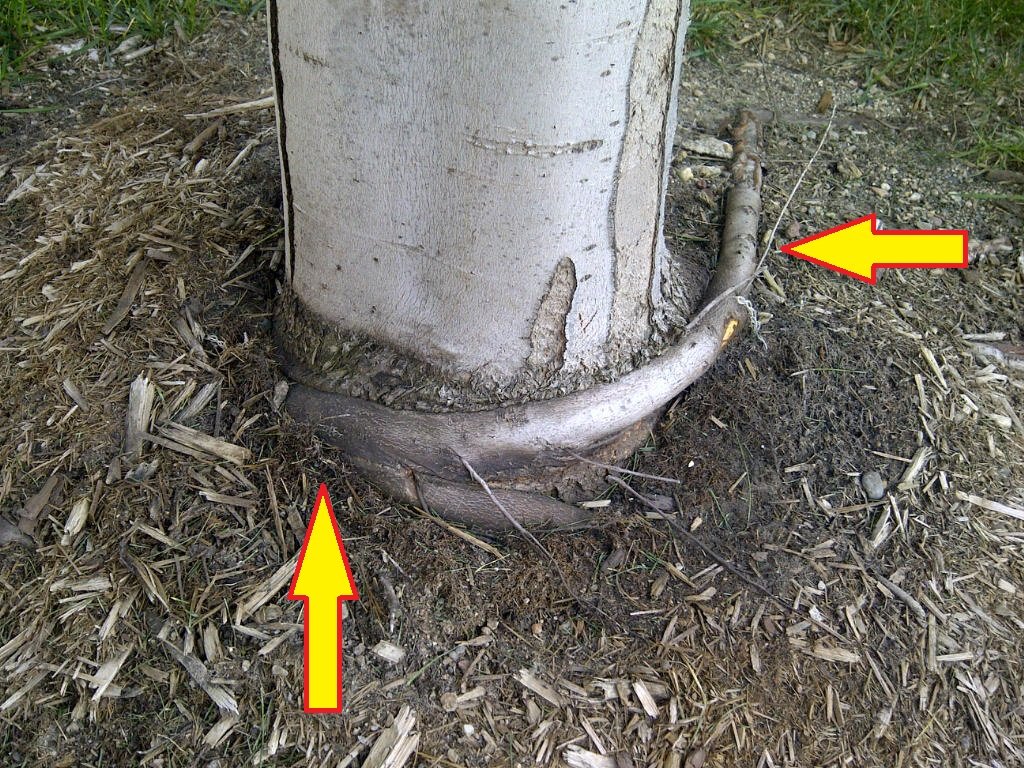Stem Girdling Roots; The Underestimated Tree Killer
In my last blog, I explored the issue with surface roots. There is often some confusion, but there is a big difference between surface roots and stem girdling roots. Stem girdling roots are roots that grow around the base of the tree compressing the cambium (first picture below). These will be discussed in this blog post. Surface roots are roots that grow at or above the surface of the lawn (second picture below).
Stem girdling roots choking a Norway maple. If left alone, these roots will eventually cause the tree to decline or potentially fail in a storm.
Surface roots on a deeply planted linden tree disrupting the lawn and potentially causing concern for the patio.
Trees versus Lawns
Trees planted in a typical urban landscape grow in an unnatural environment. Urban sites often have compacted soil, restricted root space, and are covered in a thick blanket of turf. When trees are planted in the urban environment, some issues can be expected, including surface roots and stem girdling roots.
The Basic Definition of Stem Girdling Roots
Roots that encircle a tree’s trunk, eventually compressing the trunk or other main roots.
Main Causes of Stem Girdling Roots (SGR’s)
Type of Tree-Several types of trees can develop SGR’s but maple and linden trees are the most likely to have issues.
Soil Type and Condition-Many trees tend to grow shallow roots if the soil is compact, wet or a heavy clay. In conditions in which there is low soil oxygen (and compact soil), roots will grow at or above ground level, often growing around the base of the tree.
Growing Conditions-Many trees in urban settings grow in spaces that are insufficient to handle all of the roots of a shade trees. Sometimes growing space is so limited that roots start to ground around the base of the tree.
Symptoms of Stem Girdling Roots
Scorching of leaves
Stunted growth
Twig and branch dieback
Lack of root flare
Leaning trees
Heavy crop of seeds
Recommendations for Stem Girdling Roots
1. Scenario 1 (Easy) = Excavate around base of tree and cut all SGR’s
The entire root (between 2 arrows) must be cut and removed before further compression of the trunk.
2. Scenario 2 (Aggressive) = Excavate around base of tree and remove all SGR’s. While this is an aggressive move, leaving the SGR’s alone will eventually kill the tree.
Assuming this tree still “looks healthy”, I would attempt to remove this visible SGR (and others) to save this tree. If the tree looks pretty bad already, I would lean towards removal.
3. Scenario 3 (Beyond Correction) = Assuming removal of SGR’s will not help the tree recover, plan on removal of the tree.
The stem girdling roots have been choking this tree for years and is basically fused to the trunk. The tree has been declining for years so tree removal is the best option.
The urge to leave a tree with SGR’s often results in a major failure down the road, creating a more expensive tree removal.






